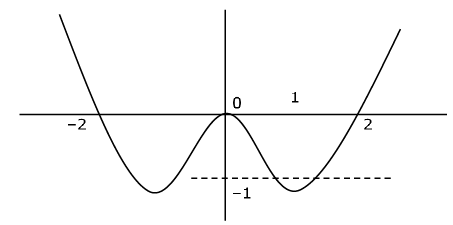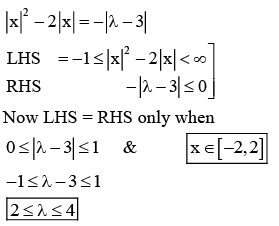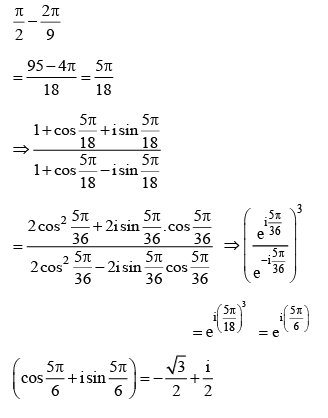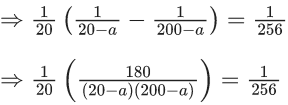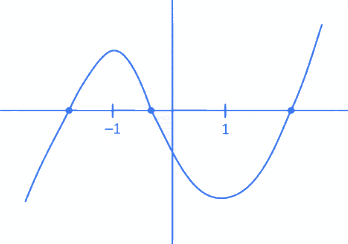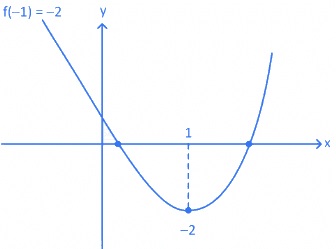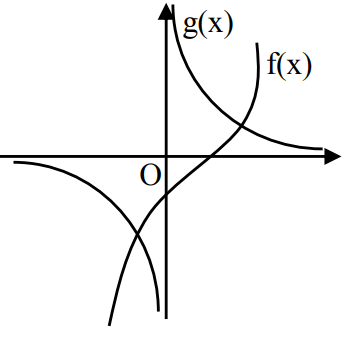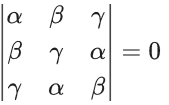Q.1. The equation x2 − 4x + [x] + 3 = x[x], where [x] denotes the greatest integer function, has : (JEE Main 2023)
(a) a unique solution in (−∞, 1)
(b) no solution
(c) exactly two solutions in (−∞, ∞)
(d) a unique solution in (−∞, ∞)
Ans. d
x2 – 4x + [x] + 3 = x [x]
x2 – 4x + 3 = (x – 1) [x]
(x – 1) (x – 3) = (x – 1) [x]
x – [x] = 3
{x} = 3
Q.2. Let λ ∈ ℝ and let the equation E be |x|2 − 2|x| + |λ − 3| = 0. Then the largest element in the set S = {x + λ: x is an integer solution of E} is (JEE Main 2023)
Ans. 5
|x| - 2| x| + |λ - 3| = 0
Q.3. The value of  (JEE Main 2023)
(JEE Main 2023)
(a) 
(b) 
(c) 
(d) 
Ans. a
Q.4. The product of all positive real values of x satisfying the equation  is ______. (JEE Advanced 2022)
is ______. (JEE Advanced 2022)
Ans. 1
Taking log to the base 5 on both sides
(16(log5x)3 − 68(log5x))(log5x) = −16
Let (log5x) = t
16t4 − 68t2 + 16 = 0
⇒ 4t4 − 16t2− t2 + 4 = 0
⇒ (4t2−1)(t2−4) = 0
⇒ t = ±(1/2), ± 2
So log5x = ±(1/2) or ±2
⇒ x = 51/2, 5(−1/2), 52, 5−2
Q.5. If  then the maximum value of a is : (JEE Main 2022)
then the maximum value of a is : (JEE Main 2022)
(a) 198
(b) 202
(c) 212
(d) 218
Ans. c
⇒ (20−a)(200−a) = 9.256
OR a2 − 220a + 1696 = 0
⇒ a = 212, 8
Q.6. Let α, β be the roots of the equation x2 − √2x + √6 = 0 and  be the roots of the equation x2 + ax + b = 0. Then the roots of the equation x2 − (a + b − 2)x + (a + b + 2) = 0 are : (JEE Main 2022)
be the roots of the equation x2 + ax + b = 0. Then the roots of the equation x2 − (a + b − 2)x + (a + b + 2) = 0 are : (JEE Main 2022)
(a) non-real complex numbers
(b) real and both negative
(c) real and both positive
(d) real and exactly one of them is positive
Ans. b
So, equation is
OR 6x2 + 17x + 7 = 0
Both roots of equation are −ve and distinct
Q.7. If α, β are the roots of the equation  then the equation, whose roots are (α + (1/β)) and (β + (1/α)), is : (JEE Main 2022)
then the equation, whose roots are (α + (1/β)) and (β + (1/α)), is : (JEE Main 2022)
(a) 3x2 − 20x − 12 = 0
(b) 3x2 − 10x − 4 = 0
(c) 3x2 − 10x + 2 = 0
(d) 3x2 − 20x + 16 = 0
Ans. b
Note : In the given equation 'x' is missing.
So,
So Equation must be option (b).
Q.8. The minimum value of the sum of the squares of the roots of x2 + (3 − a)x + 1 = 2a is: (JEE Main 2022)
(a) 4
(b) 5
(c) 6
(d) 8
Ans. c
α + β = a−3, αβ = 1−2a
⇒ α2 + β2 = (a−3)2 −2(1 − 2a)
= a2 − 6a + 9 − 2 + 4a
= a2 − 2a + 7
= (a−1)2 + 6
So, α2 + β2 ≥ 6
Q.9. Let S be the set of all integral values of α for which the sum of squares of two real roots of the quadratic equation 3x2 + (α − 6)x + (α + 3) = 0 is minimum. Then S : (JEE Main 2022)
(a) is an empty set
(b) is a singleton
(c) contains exactly two elements
(d) contains more than two elements
Ans. a
Given quadratic equation,
3x2 +(α−6)x + (α+3) = 0
Let, a and b are the roots of the equation,
∴ a + b = −(α−6)/3
and ab = (α+3)/3
For real roots,
D ≥ 0
⇒ (α−6)2 − 4.3.(α + 9) ≥ 0
⇒ α2−12α + 36 − 12α − 36 ≥ 0
⇒ α2 − 24 α ≥ 0
⇒ α(α−24)≥0
∴ α > 24 or α<0
∴ Real roots of the equation possible for α>24 or α<0.
Now, sum of square of roots
= a2 + b2
= (a + b)2 - 2ab
∴ Sum of square of roots are minimum when a2 + b2 = minimum.
Value of quadratic equation α2 − 18α + 18 is minimum at
But for real roots α should be less than 0 or greater than 24.
So, there is no value of α in the range α > 24 ∪ α < 0 where sum of squares of two real roots is minimum.
∴ S is an empty set.
Q.10. If the sum of the squares of the reciprocals of the roots α and β of the equation 3x2 + λx − 1 = 0 is 15, then 6(α3 + β3)2 is equal to : (JEE Main 2022)
(a) 18
(b) 24
(c) 36
(d) 96
Ans. b
3x2 + λx − 1 = 0
Given, two roots are α and β.
∴ Sum of roots = α + β = ((−λ)/3)
And product of roots = αβ = ((−1)/3)
Given that,
Sum of square of reciprocal of roots α and β is 15.
⇒ λ2 + 6 = 15
⇒ λ2 = 9
Now, 6(α3 + β3)2
= 6{(α + β)(α2 + β2 − αβ)}2
= 6 x (2)2
= 6 x 4 = 24
Q.11. The number of distinct real roots of the equation x7 − 7x − 2 = 0 is (JEE Main 2022)
(a) 5
(b) 7
(c) 1
(d) 3
Ans. d
Given equation x7 − 7x − 2 = 0
Let f(x) = x7 − 7x − 2
f′(x) = 7x6 − 7 = 7(x6 − 1)
and f′(x) = 0 ⇒ x = +1
and f(−1) = −1 + 7 − 2 = 5 > 0
f(1) = 1 − 7 − 2 = −8 < 0
So, roughly sketch of f(x) will be
So, number of real roots of f(x) = 0 and 3
Q.12. The sum of all the real roots of the equation (e2x − 4)(6e2x − 5ex + 1) = 0 is (JEE Main 2022)
(a) loge3
(b) -loge3
(c)loge6
(d) -loge6
Ans. b
(e2x − 4)(6e2x − 5ex + 1) = 0
Let ex = t
∴ (t2 − 4)(6t2 − 5t + 1) = 0
⇒(t2 − 4)(2t − 1)(3t − 1) = 0
∴ t = 2, −2, (1/2), (1/3)
∴ ex = 2 ⇒ x = ln2
ex = −2 (not possible)
ex = (1/2) ⇒ x = −ln2
ex = (1/3) ⇒ x = −ln3
∴ Sum of all real roots
= ln2 − ln2 − ln3
= − ln3
Q.13. Let a, b ∈ R be such that the equation ax2 − 2bx + 15 = 0 has a repeated root α. If α and β are the roots of the equation x2 − 2bx + 21 = 0, then α2 + β2 is equal to : (JEE Main 2022)
(a) 37
(b) 58
(c) 68
(d) 92
Ans. b
ax2 − 2bx + 15 = 0 has repeated root so b2 = 15a and α = 15b
∵ α is a root of x2 − 2bx + 21 = 0
So 225/(b2) = 9 ⇒ b2 = 25
Now α2 + β2 = (α + β)2 − 2αβ = 4b2 − 42 = 100 − 42 = 58
Q.14. The number of distinct real roots of x4 − 4x + 1 = 0 is : (JEE Main 2022)
(a) 4
(b) 2
(c) 1
(d) 0
Ans. b
f(x) = x4 - 4x + 1 = 0
f'(x) = 4x3 - 4
= 4(x - 1)(x2 + 1 + x)
⇒ Two solution
Q.15. The number of real solutions of x7 + 5x3 + 3x + 1 = 0 is equal to _____. (JEE Main 2022)
(a) 0
(b) 1
(c) 3
(d) 5
Ans. b
Q.16. Let f(x) be a quadratic polynomial such that f(−2) + f(3) = 0. If one of the roots of f(x) = 0 is −1, then the sum of the roots of f(x) = 0 is equal to : (JEE Main 2022)
(a) 11/3
(b) 7/3
(c) 13/3
(d) 14/3
Ans. a
∵ x = −1 be the roots of f(x) = 0
∴ Let f(x) = A(x + 1)(x − 1) ...... (i)
Now, f(−2) + f(3) = 0
⇒ A[−1(−2 − b) + 4(3 − b)] = 0
b = (14/3)
∴ Second root of f(x) = 0 will be 14/3
∴ Sum of roots =(14/3) − 1 = (11/3)
Q.17. Let α be a root of the equation 1 + x2 + x4 = 0. Then, the value of α1011 + α2022 − α3033 is equal to : (JEE Main 2022)
(a) 1
(b) α
(c) 1 + α
(d) 1 + 2α
Ans. a
Given, α is a root of the equation 1 + x2 + x4 = 0
∴ α will satisfy the equation.
∴ 1 + α2 + α4 = 0
∴ α2 = ωarω2
Now,
α1011 + α2022 − α3033
= α.(α2)505 + (α2)1011 − α.(α2)1516
= α(ω)505 + (ω)1011 − α.(ω)1516
= α.(ω3)168.ω + (ω3)337 − α.(ω3)505.ω
= αω + 1 − αω
= 1
Q.18. Let α, β(α > β) be the roots of the quadratic equation x2 − x − 4 = 0. If Pn = αn − βn, n ∈ N, then  is equal to _____. (JEE Main 2022)
is equal to _____. (JEE Main 2022)
Ans. 16
α and β are the roots of the quadratic equation x2 − x − 4 = 0.
∴ α and β are satisfy the given equation.
α2 − α − 4 = 0
⇒ αn + 1 − αn − 4αn − 1 = 0 ...... (1)
and β2 − β − 4 = 0
⇒ βn+1 − βn − 4βn−1 = 0 ...... (2)
Substituting (2) from (1), we get,
(αn+1 − βn+1)−(αn − βn)−4(αn − 1 − βn − 1) = 0
⇒ Pn +1 − Pn − 4Pn−1 = 0
⇒ Pn+1 = Pn + 4Pn−1
⇒ Pn+1 − Pn = 4Pn−1
For n = 14, P15 − P14 = 4P13
For n = 15, P16 − P15 = 4P14
Now,
= 16
Q.19. The sum of all real values of x for which  is equal to _____. (JEE Main 2022)
is equal to _____. (JEE Main 2022)
Ans. 6
Either x2 + x + 1 = 0 or No real roots
⇒ 5x2 − 7x + 19 = 3x2 + 5x + 12
2x2 − 12x + 7 = 0
sum of roots = 6.
Q.20. The number of distinct real roots of the equation x5(x3 − x 2 − x + 1) + x(3x3 − 4x2 − 2x + 4) − 1 = 0 is _______. (JEE Main 2022)
Ans. 3
x8 − x7 − x6 + x5 + 3x4 − 4x3 − 2x2 + 4x − 1 = 0
⇒ x7(x − 1) − x5(x − 1) + 3x3(x − 1) − x(x2 − 1) + 2x(1 − x) + (x − 1) = 0
⇒ (x − 1)(x7 − x5 + 3x3−x(x + 1)−2x + 1)= 0
⇒ (x − 1)(x7 − x5 + 3x3 − x2 − 3x + 1) = 0
⇒ (x − 1)(x5(x2 − 1) + 3x(x2−1)−1(x2−1)) = 0
⇒ (x − 1)(x2 − 1)(x5 + 3x − 1) = 0
∴ x = ±1 are roots of above equation and x5 + 3x − 1 is a monotonic term hence vanishs at exactly one value of x other than 1 or −1.
∴ 3 real roots.
Q.21. If for some  not all have same sign, one of the roots of the equation (p2 + q2)x2 − 2q(p + r)x + q2 + r2 = 0 is also a root of the equation x2 + 2x − 8 = 0, then (q2 + r2)/p2 is equal to ____________, (JEE Main 2022)
not all have same sign, one of the roots of the equation (p2 + q2)x2 − 2q(p + r)x + q2 + r2 = 0 is also a root of the equation x2 + 2x − 8 = 0, then (q2 + r2)/p2 is equal to ____________, (JEE Main 2022)
Ans. 272
Let roots of
∴ α + β > 0 and αβ > 0
Also, it has a common root with x2 + 2x − 8 = 0
∴ The common root between above two equations is 4.
⇒ 16(p2 + q2)−8q(p + r)+ q2 + r2 = 0
⇒ (16p2 − 8pq + q2) + (16q2 − 8qr + r2) = 0
⇒ (4p − q)2+ (4q − r)2 = 0
⇒ q = 4p and r = 16p∴

Q.22. Let for f(x) = a0x2 + a1x + a2,f′(0) = 1 and f′(1) = 0. If a0, a1, a2 are in an arithmatico-geometric progression, whose corresponding A.P. has common difference 1 and corresponding G.P. has common ratio 2, then f(4) is equal to _____. (JEE Main 2022)
Ans. 2
Given,
f(x) = a0x2 + a1x + a2
f′(0) = 1
f′(1) = 0
a0, a1, a2 are in A. G. P
Common difference of AP = 1
Common ratio of GP = 2
A.P terms = a, a + 1, a + 2
G.P terms = y, ry, r2y
∴ AGP terms = ay, (a + 1)ry, (a + 2)r2y
∴ a0 = ay
a1 = (a + 1)ry = (a + 1)2y
a2 = (a + 2)r2y = (a + 2)4y
Now, f′(x) = 2xa0 + a1
∴ f′(0) = a1 = 1
and f′(1) = 2a0 + a1 = 0
⇒ 2a0 + 1 = 0
⇒ a0 = −12
∴ ay = −(1/2)
and (a + 1)2y = 1
⇒ 2ay + 2y = 1
⇒ 2 × (−(1/2))+2y=1
⇒ 2y = +2
⇒ y = +1
∴ a = −(1/2)
∴ a2 = (a + 2)4y
= (−(1/2) + 2) × 4.1
= 6
∴ f(x) = −(1/2)x2 + x + 6
∴ f(4) = −(1/2)(4)2 + 4 + 6
= − 8 + 10
= 2
Q.23. Let p and q be two real numbers such that p + q = 3 and p4 + q4 = 369. Then ((1/p) + (1/q))−2 is equal to ______. (JEE Main 2022)
Ans. 4
∵ p + q = 3 ...... (i)
and p4 + q4 = 369 ...... (ii)
{(p+q)2 − 2pq}2 − 2p2q2 = 369
or (9 − 2pq)2 − 2(pq)2 = 369
or (pq)2 − 18pq − 144 = 0
∴ pq = −6 or 24
But pq = 24 is not possible
∴ pq = −6
Hence,
Q.24. The sum of the cubes of all the roots of the equation x4 − 3x3 − 2x2 + 3x + 1 = 0 is _______. (JEE Main 2022)
Ans. 36
x4 − 3x3 − x2 − x2 + 3x + 1 = 0
(x2 − 1)(x2 − 3x − 1) = 0
Let the root of x2 − 3x − 1 = 0 be α and β and other two roots of given equation are 1 and −1
So sum of cubes of roots
= 13 + (−1)3 + α3 + β3
= (α+β)3 − 3αβ(α + β)
= (3)3 − 3(−1)(3)
= 36
Q.25. If the sum of all the roots of the equation e2x − 11ex− 45e−x+ (81/2) = 0 is logep, then p is equal to ______. (JEE Main 2022)
Ans. 45
Let ex = t then equation reduces to
⇒ 2t3 − 22t2 + 81t − 45 = 0 ..... (i)
if roots of e2x − 11ex − 45e−x + (81/2) = 0 are α, β, γ then roots of (i) will beusing product of roots
⇒ α1 + α2 + α3 = ln 45 ⇒ p = 45
Q.26. Let α, β be the roots of the equation x2 − 4λx + 5 = 0 and α, γ be the roots of the equation x2 − (3√2 + 2√3)x + 7 + 3λ√3 = 0, λ > 0. If β + γ = 3√2, then (α + 2β + γ)2 is equal to ____. (JEE Main 2022)
Ans. 98
∵ α, β are roots of x2 − 4λx + 5 = 0
∴ α + β = 4λ and αβ = 5
Also, α, γ are roots of
x2 − (3√2 + 2√3)x + 7 + 3√3λ = 0, λ > 0
∴ α + γ = 3√2 + 2√3, αγ = 7 + 3√3λ
∵ α is common root
∴ α2 − 4λα + 5 = 0 ....... (i)
and α2 − (3√2 + 2√3)α + 7 + 3√3λ = 0 ...... (ii)
From (i) - (ii) : we get
∴ λ = 2
∴ (α + 2β + γ)2 = (α + β + β + γ)2
= (4√2 + 3√2)2
= (7√2)2 = 98
Q.27. The number of real solutions of the equation e4x + 4e3x − 58e2x + 4ex + 1 = 0 is _____. (JEE Main 2022)
Ans. 2
Dividing by e2x
e2x + 4ex − 58 + 4e−x + e−2x = 0
⇒(ex + e−x)2 + 4(ex + e−x) − 60 = 0
Let ex + e−x = t ∈ [2, ∞)
⇒ t2 + 4t − 60 = 0
⇒ t = 6 is only possible solution
ex + e−x = 6 ⇒ e2x − 6ex + 1 = 0
Let ex = p,
p2 − 6p + 1 = 0
Q.28. The numbers of pairs (a, b) of real numbers, such that whenever α is a root of the equation x2 + ax + b = 0, α2 − 2 is also a root of this equation, is : (JEE Main 2021)
(a) 6
(b) 2
(c) 4
(d) 8
Ans. a
Consider the equation x2 + ax + b = 0
If has two roots (not necessarily real α & β)
Either α = β or α ≠ β
Case (1) If α = β, then it is repeated root. Given that α2 − 2 is also a root
So, α = α2 − 2 ⇒ (α + 1)(α − 2) = 0
⇒ α = −1 or α = 2
When α = −1 then (a, b) = (2, 1)
α = 2 then (a, b) = (−4, 4)
Case (2) If α ≠ β
Then
(I) α = α2 − 2 and β = β2 − 2
Hence, (a, b) = (−(α + β), αβ)
(−1, −2)
(II) α = β2 − 2 and β = α2 − 2
Then α − β = β2 − α2 = (β − α) (β + α)
Since α ≠ β we get α + β = β2 + α2 − 4
α + β = (α + β)2 − 2αβ − 4
Thus −1 = 1 −2 αβ − 4 which implies
αβ = −1 Therefore (a, b) = (−(α + β), αβ)
= (1, −1)
(III) α = α2 − 2 = β2 − 2 and α ≠ β
⇒ α = − β
Thus α = 2, β = −2
α = −1, β = 1
Therefore (a, b) = (0, −4) & (0, 1)
(IV) β = α2 − 2 = β2 − 2 and α ≠ β is same as (III) Therefore we get 6 pairs of (a, b)
Which are (2, 1), (−4, 4), (−1, −2), (1, −1), (0, −4)
Option (a)
Q.29. The sum of the roots of the equation x + 1 − 2log2(3 + 2x) + 2log4(10 − 2−x) = 0, is :
(a) log2 14
(b) log2 11
(c) log2 12
(d) log2 13
Ans. b
x + 1 − 2log2(3 + 2x) + 2log4(10 − 2−x) = 0
log2(2x+1 )− log2(3+2x)2 + log2(10 − 2−x) = 0
⇒ 20.2x − 2 = 9 + 22x + 6.2x
∴ (2x)2 − 14(2x) + 11 = 0
Roots are
x1 + x2 = log2(11)
Q.30. cosec18∘ is a root of the equation : (JEE Main 2021)
(a) x2 + 2x − 4 = 0
(b) 4x2 + 2x − 1 = 0
(c) x2 − 2x + 4 = 0
(d) x2 − 2x − 4 = 0
Ans. d
Let cosec18∘ = x = √5 + 1
⇒ x−1 = √5
Squaring both sides, we get
x2 − 2x + 1 = 5
⇒ x2 - 2x - 4 = 0
Q.31. The set of all values of K > −1, for which the equation (3x2 + 4x + 3)2 − (k + 1)(3x2 + 4x + 3)(3x2 + 4x + 2) + k(3x2 + 4x + 2)2 = 0 has real roots, is : (JEE Main 2021)
(a) (1, (5/2)]
(b) [2, 3)
(c) [-(1/2), (1)
(d) 
Ans. a
(3x2 + 4x + 3)2 − (k + 1)(3x2 + 4x + 3)(3x2 + 4x + 2) + k(3x2 + 4x + 2)2 = 0
Let 3x2 + 4x + 3 = a
and 3x2 + 4x+ 2= b ⇒ b = a − 1
Given equation becomes
⇒ a2 − (k + 1)ab + kb2 = 0
⇒ a(a − kb) − b(a − kb) = 0
⇒ (a − kb)(a − b) = 0 ⇒ a = kb or a = b (reject) ∵ a = kb
⇒ 3x2 + 4x + 3 = k(3x2 + 4x + 2)
⇒ 3(k − 1)x2 + 4(k − 1)x + (2k − 3) = 0 for real roots
D ≥ 0
⇒ 16(k − 1)2 − 4(3(k − 1))(2k − 3) ≥ 0
⇒ 4(k − 1){4(k − 1) − 3(2k − 3)} ≥ 0
⇒ 4(k− 1){−2k + 5} ≥ 0
⇒ −4(k − 1){2k − 5} ≥ 0
⇒ (k − 1)(2k − 5) ≤ 0
∴ k ∈ [1, (5/2)]
∴ k ≠ 1
∴ k ∈ (1, (5/2))
Q.32. Let α, β be two roots of the equation x2 + (20)1/4x + (5)1/2 = 0. Then α8 + β8 is equal to (JEE Main 2021)
(a) 10
(b) 100
(c) 50
(d) 160
Ans. c
x2 + (20)1/4x + (5)1/2 = 0
⇒ x2 + √5 = - (20)1/4x
Squaring both sides, we get
⇒ x4 = −5 ⇒ x8 = 25
⇒ α8 + β8 = 50
Q.33. The number of real solutions of the equation, x2 − |x| − 12 = 0 is : (JEE Main 2021)
(a) 2
(b) 3
(c) 1
(d) 4
Ans. a
|x|2 − |x| − 12 = 0
⇒ (|x| + 3)(|x| − 4) = 0
⇒ |x| = 4
⇒ x = ±2
Q.34. Let  If 8x2 + bx + c = 0 is a quadratic equation whose roots are α1/5 and β1/5, then the value of c − b is equal to : (JEE Main 2021)
If 8x2 + bx + c = 0 is a quadratic equation whose roots are α1/5 and β1/5, then the value of c − b is equal to : (JEE Main 2021)
(a) 42
(b) 47
(c) 43
(d) 50
Ans. a
= max{26sin3x.28cos3x}
= max{26sin3x+8cos3x}
and β = min{82sin3x.44cos3x} = min{26sin3x + 8cos3x}
Now range of 6sin3x + 8cos3x
α = 210 & β = 2−10
So, α1/5 = 22 = 4
⇒ β1/5 = 2−2 = 1/4
quadratic 8x2 + bx + c = 0
c/8 = 1 ⇒ c = 8
∴ c – b = 8 + 34 = 42
Q.35. The number of real roots of the equation e6x − e4x − 2e3x − 12e2x + ex + 1 = 0 is : (JEE Main 2021)
(a) 2
(b) 4
(c) 6
(d) 1
Ans. a
e6x − e4x−2e3x−12e2x + ex + 1 = 0
⇒ (e3x − 1)2 − ex(e3x − 1) = 12e2x
(e3x − 1)2(ex − e−x − e−2x) = 12
⇒ No. of real roots = 2
Q.36. If α and β are the distinct roots of the equation x2 + (3)1/4x + 31/2 = 0, then the value of α96(α12−1) + β96(β12−1) is equal to : (JEE Main 2021)
(a) 56 x 325
(b) 56 x 324
(c) 52 x 324
(d) 28 x 325
Ans. c
As, (α2 + √3)=−(3)1/4.α
⇒ (α4 +2√3α2 + 3) = √3α2 (On squaring)
∴ (α4 + 3) = (−)√3α2
⇒ α8 + 6α4 + 9 = 3α4 (Again squaring)
∴ α8 + 3α4 + 9 = 0
⇒ α8 = −9 − 3α4
(Multiply by α4)
So, α12 = −9α4 − 3α8
∴ α12 = −9α4 − 3(−9−3α4)
⇒ α12 = −9α4 + 27 + 9α4
Hence, α12 = (27)2
⇒ (α12)8 = (27)8
⇒ α96 = (3)24
Similarly β96 = (3)24
∴ α96(α12−1) + β96(β12−1) = (3)24 × 52
⇒ Option (3) is correct.
Q.37. The value of  is equal to (JEE Main 2021)
is equal to (JEE Main 2021)
(a) 1.5 + √3
(b) 2 + √3
(c) 3 + 2√3
(d) 4 + √3
Ans. a
⇒ (4x+1)(x−3)=x
⇒ 4x2 −12x + x − 3 = x
⇒ 4x2 −12x − 3 = 0
But only positive value is accepted
So, x = 1.5 + √3
Q.38. Let α, β, γ be the real roots of the equation, x3 + ax2 + bx + c = 0, (a, b, c ∈ R and a, b ≠ 0). If the system of equations (in u, v, w) given by αu + βv + γw = 0, βu + γv + αw = 0; γu + αv + βw = 0 has non-trivial solution, then the value of a2/b is (JEE Main 2021)
(a) 5
(b) 3
(c) 1
(d) 0
Ans. b
x3 + ax2 + bx + c = 0
Roots are α, β, γ.
For non-trivial solutions,
⇒ α3 + β3 + γ3 − 3αβγ = 0
⇒ (α + β + γ)[(α + β + α)2 − 3(∑αβ)] = 0
⇒ (−a)[a2 − 3b] = 0
⇒ a2 = 3b (∵ a ≠ 0)
⇒ a2/b = 3
Q.39. The value of  is: (JEE Main 2021)
is: (JEE Main 2021)
(a) 
(b) 
(c) 
(d) 
Ans. a
Q.40. Let α and β be the roots of x2 − 6x − 2 = 0. If an = αn − βn for n ≥ 1, then the value of  is : (JEE Main 2021)
is : (JEE Main 2021)
(a) 3
(b) 2
(c) 4
(d) 1
Ans. b
Given, α and β be the roots of x2 − 6x − 2 = 0
α + β = 6
αβ = −2
and α2 − 6α − 2 = 0 ⇒ α2 − 2 = 6α
β2 − 6β − 2 = 0 ⇒ β2 − 2 = 6β
Q.41. The integer 'k', for which the inequality x2 − 2(3k − 1)x + 8k2 − 7 > 0 is valid for every x in R, is : (JEE Main 2021)
(a) 4
(b) 2
(c) 3
(d) 0
Ans. c
x2 − 2(3k−1)x + 8k2 − 7 > 0
Now, D < 0
⇒ 4(3k−1)2 − 4 × 1 × (8k2 − 7) < 0
⇒ 9k2 − 6k + 1 − 8k2 + 7 < 0
⇒ k2 − 6k + 8 < 0
⇒ (k−4)(k−2) < 0
2 < k < 4
then k = 3
Q.42. Let p and q be two positive numbers such that p + q = 2 and p4 + q4 = 272. Then p and q are roots of the equation : (JEE Main 2021)
(a) x2 – 2x + 8 = 0
(b) x2 - 2x + 136 = 0
(c) x2 – 2x + 16 = 0
(d) x2 – 2x + 2 = 0
Ans. c
p2 + q2 = (p+q)2 −2pq
= 4 − 2pq
Now, (p2 + q2)2 = p4 + q4 + 2p2q2
⇒ (4−2pq)2 = 272 + 2p2q2
⇒ 16+4p2q2−16pq = 272 + 2p2q2
⇒ 2p2q2−16pq − 256 = 0
⇒ p2q2 − 8pq − 128 = 0
⇒ (pq − 16)(pq + 8) = 0
⇒ pq = 16, −8
Here, pq = - 8 is not possible as p and q are positive.
∴ pq = 16
Now, the equation whose roots are p and q is
x2 − 2x + 16 = 0
Q.43. For x ∈ R, the number of real roots of the equation 3x2 − 4|x2 − 1| + x − 1 = 0 is ________. (JEE Advanced 2021)
Ans. 4
Given,
3x2 − 4|x2 − 1| + x − 1 = 0 .... (i)
For −1 ≤ x ≤ 1 i.e., x∈[−1, 1]
From Eq. (i), we get
3x2 − 4(−x2 + 1) + x − 1 = 0
⇒ 3x2 + 4x2 − 4 + x − 1 = 0
⇒ 7x2 + x − 5 = 0
Here, both values of x are acceptable.
For | x | > | i.e. x ∈(− ∞, −1) ∪ (1, ∞)
From Eq. (i), we get
3x2 − 4(x2 − 1) + x − 1 = 0
⇒ x2 − x − 3 = 0
Again here, both values of x are acceptable.
Hence, total number of solutions is 4.
Q.44. Let f(x) be a polynomial of degree 3 such that f(k) = −(2/k) for k = 2, 3, 4, 5. Then the value of 52 − 10f(10) is equal to : (JEE Main 2021)
Ans. 26
kf(k) + 2 = λ(x−2)(x−3)(x−4)(x−5) .... (1)
put x = 0
we get λ = 1/60
Now, put λ in equation (1)
⇒ kf(k) +2 = (1/60)(x−2)(x−3)(x−4)(x−5)
Put x = 10
⇒ 10f(10) + 2 = (1/60) (8) (7) (6) (5)
⇒ 52 − 10f(10) = 52 − 26 = 26
Q.45. Let λ ≠ 0 be in R. If α and β are the roots of the equation x2 − x + 2λ = 0, and α and γ are the roots of equation 3x2 − 10x + 27λ = 0, then (βγ/λ) is equal to ________. (JEE Main 2021)
Ans. 18
3α2 − 10α + 27λ = 0 ..... (1)
α2 − α + 2λ = 0 ...... (2)
(1) − 3(2) gives
−7α + 21λ = 0 ⇒ α = 3λ
Put α = 3λ in equation (1) we get
9λ2 − 3λ + 2λ − 0
9λ2 = λ ⇒ λ = (1/9) as λ ≠ 0
Now, α = 3λ ⇒ λ = 1/3
α + β = 1 ⇒ β = 2/3
α + γ = (10/3) ⇒ γ = 3
Q.46. The sum of all integral values of k (k ≠ 0) for which the equation  in x has no real roots, is ____. (JEE Main 2021)
in x has no real roots, is ____. (JEE Main 2021)
Ans. 66
⇒ k(2x − 4 − x + 1) = 2(x2 − 3x + 2)
⇒ k(x − 3) = 2(x2 − 3x + 2)
⇒ 2(x − 3 + 2/(x−3) + 3) ∈ (−∞, 6 − 4√2] ∪ [6 + 4√2, ∞)
for no real roots
k ∈ (6 − 4√2, 6 + 4√2)−{0}
Integral k ∈ {1, 2 ..... 11}
Sum of k = 66
Q.47. If a + b + c = 1, ab + bc + ca = 2 and abc = 3, then the value of a4 + b4 + c4 is equal to _____. (JEE Main 2021)
Ans. 13
(a + b + c)2 = 1
⇒ a2 + b2 + c2 + 2(ab + bc + ca) = 1
⇒ a2 + b2 + c2 = – 3 ….(i)
⇒ ab + bc + ca = 2 ….(ii)
Squaring of equation (ii),
⇒ a2b2 + b2c2 + c2a2 + 2(ab2c + bc2a + ca2b) = 4
⇒ a2b2 + b2c2 + c2a2 + 2abc(a + b + c) = 4
⇒ a2b2 + b2c2 + c2a2 + 6 = 4
⇒ a2b2 + b2c2 + c2a2 = – 2 ….(iii)
Squaring of equation (i),
⇒ a4 + b4 + c4 + 2(a2b2 + b2c2 + c2a2) = 9
⇒ a4 + b4 + c4 – 4 = 9
⇒ a4 + b4 + c4 = 13
Q.48. The number of real roots of the equation e4x − e3x − 4e2x − ex + 1 = 0 is equal to _____. (JEE Main 2021)
Ans. 2
t4 − t3 − 4t2 − t + 1 = 0, ex = t > 0
⇒ t2 − t − 4 − (1/t) + 1/(t2) = 0
⇒ α2 − α − 6 = 0, α = t + (1/t) ≥ 2
⇒ α = 3, − 2 (reject)
⇒ t + (1/t) = 3
⇒ The number of real roots = 2
Q.49. If α, β are roots of the equation x2 + 5(√2)x + 10 = 0, α > β and Pn = αn − βn for each positive integer n, then the value of  is equal to _______. (JEE Main 2021)
is equal to _______. (JEE Main 2021)
Ans. 1
x2 + 5√2x + 10 = 0
& Pn = αn − βn (Given)
Now,
Since, α + 5√2 = −10/α ..... (1)
& β + 5√2 = −10/β ....... (2)
Now, put there values in above expression = -
Q.50. The number of solutions of the equation log(x+1)(2x2 + 7x + 5) + log(2x+5)(x+1)2 − 4 = 0, x > 0, is (JEE Main 2021)
Ans. 1
log(x+1)(2x2+7x+5) + log(2x+5)(x+1)2 − 4 = 0
log(x+1)(2x+5)(x+1) + 2log(2x+5)(x+1) = 4
log(x+1)(2x+5) + 1 + 2log(2x+5)(x+1) = 4
Put log(x+1)(2x+5) = t
t + (2/t) = 3 ⇒ t2 − 3t + 2 = 0
t = 1, 2
log(x+1)(2x+5) = 1 & log(x+1)(2x+5) = 2
x+1 = 2x+3 & 2x+5 = (x+1)2
x = −4 (rejected)
x2 = 4 ⇒ x = 2, −2 (rejected)
So, x = 2
No. of solution = 1
Q.51. Let α and β be two real numbers such that α + β = 1 and αβ = −1. Let pn = (α)n + (β)n, pn−1 = 11 and pn+1 = 29 for some integer n ≥ 1. Then, the value of pn2 is ______. (JEE Main 2021)
Ans. 324
Given, α + β = 1, αβ = − 1
∴ Quadratic equation with roots α, β is x2 − x − 1 = 0
⇒ α2 = α + 1
Multiplying both sides by αn−1
αn+1 = αn + αn−1 ......(1)
Similarly,
βn + 1 = βn + βn + 1 ..... (2)
Adding (1) & (2)
αn+1 + βn+1 = (αn+βn) + (αn−1 + βn−1)
⇒ Pn+1 = Pn + Pn−1
⇒ 29 = Pn + 11 (Given, Pn + 1 = 29, Pn − 1 = 11)
⇒ Pn = 18
∴ Pn2 = 182 = 324
Q.52. The sum of 162th power of the roots of the equation x3 − 2x2 + 2x − 1 = 0 is ________. (JEE Main 2021)
Ans. 3
x3 − 2x2 + 2x − 1 = 0
x = 1 satisfying the equation
∴ x − 1 is factor of
x3 − 2x2 + 2x − 1
= (x − 1) (x2 − x + 1) = 0
x = 1,
x = 1, − ω2, −ω
Sum of 162th power of roots
= (1)162 + (−ω2)162 + (−ω)162
= 1 + (ω)324 + (ω)162
= 1 + 1 + 1 = 3
Q.53. The number of solutions of the equation log4(x − 1) = log2(x − 3) is _________. (JEE Main 2021)
Ans. 1
log4(x−1) = log2(x−3)
⇒ (1/2)log2(x−1) = log2(x−3)
⇒ log2(x−1)1/2= log2(x−3)
⇒ (x−1)1/2= log2(x−3)
⇒ (x−1)1/2 = x−3
⇒ x−1 = x2 + 9 − 6x
⇒ x2−7x+10 = 0
⇒ (x−2)(x−5) = 0
⇒ x = 2, 5
But x ≠ 2 because it is not satisfying the domain of given equation i.e. log2(x − 3) → its domain x > 3 finally x is 5
∴ No. of solutions = 1.
Q.54. The number of the real roots of the equation (x+1)2 + |x−5| = (27/4) is ________. (JEE Main 2021)
Ans. 2
When x>5
(x+1)2 + (x−5) = 27/4
⇒ x2 + 3x − 4 = 27/4
⇒ x2 + 3x − 43/4 = 0
⇒ 4x2 + 12x − 43 = 0
= 2.1, -5.1 [ both are rejected as x should be > 5 ]
(Therefore no solution)
For x ≤ 5
(x+1)2 − (x−5) = 27/4
x2 + x + 6 − 27/4 = 0
4x2 + 4x − 3 = 0
∴ So, the equation have two real roots.


